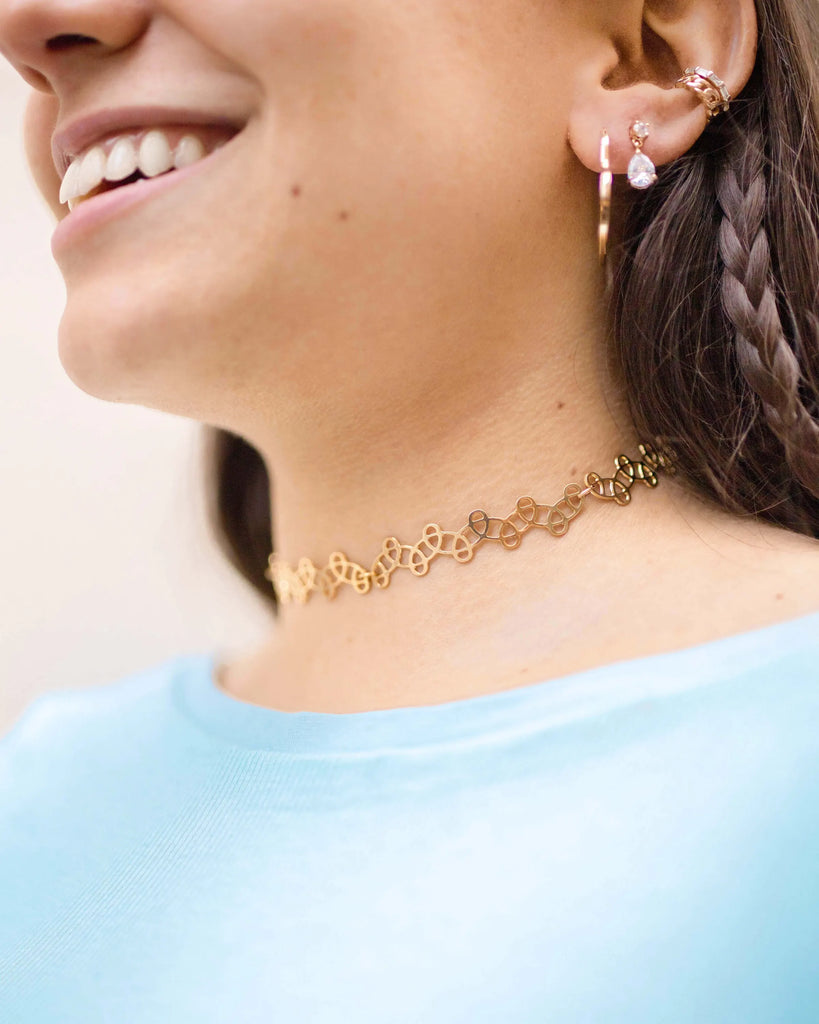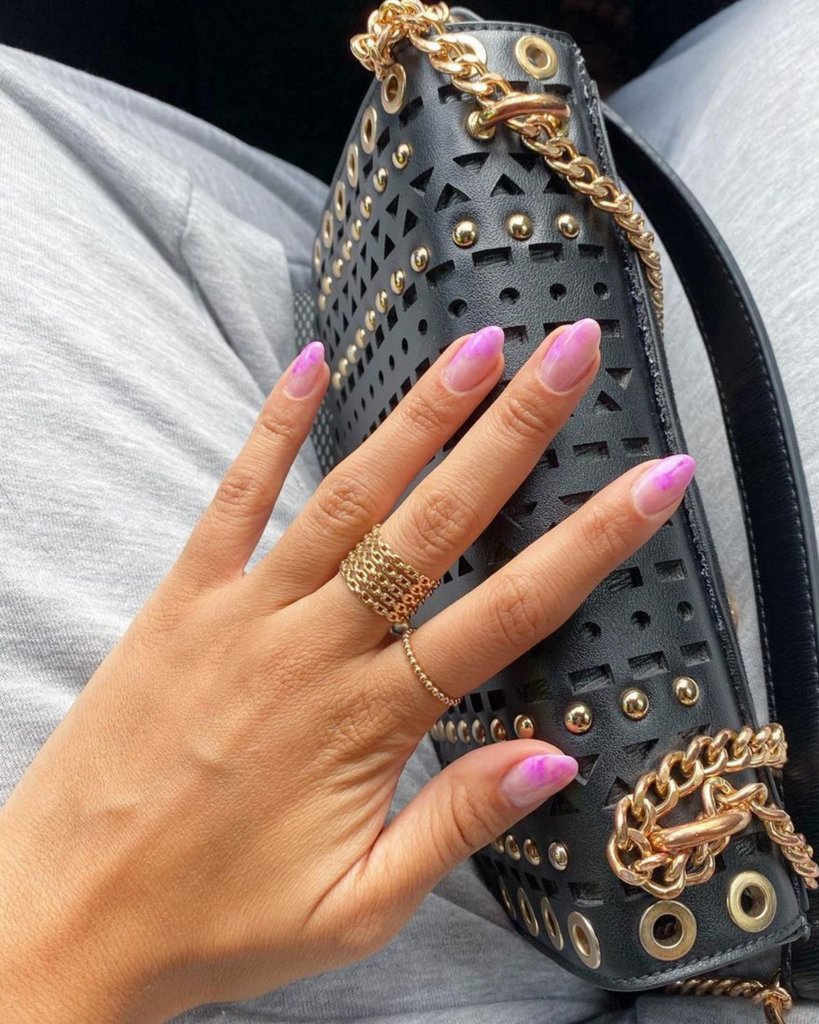Stylish and affordable, gold-plated jewelry lets us shine without breaking the bank!
But what exactly is gold plating? How is it made? How does it differ from "gold-plated"? We explain it all to you!
( Are you more of a silver team? We give you all our advice for your silver jewelry ! )
🕐 Playback time: 6 mins
Contents :
If you've fallen for one of our little rings, you can find them here.
Making gold-plated jewelry
"Gold-plated jewelry" is a misleading term! No, not all gold-plated jewelry is gold-plated! There is a precise technique and legislation that determines whether or not a piece of jewelry can be called "gold-plated". The plating technique dates back several centuries, but has since evolved considerably. Gone are the days when gilding was done with gold leaf!
Today, we use a chemical process called electroplating. Through electrolysis, this process deposits a dissolved precious metal (gold in this case) on the surface of a metal jewel (usually brass or copper). Under French law, a piece of jewelry can be considered "gold-plated" if it is covered with a MINIMUM thickness of 3 microns of gold (3UM). The gold used for plating is generally 14 or 18 carat gold. The result is a perfectly gold-plated piece of jewelry that will last a lifetime! Thanks to this techniqueor jewelry that turns your skin green!
The difference between gold, gold plating and fine gold plating
What is gold?
You've probably heard of the famous 24-carat (or 24k) gold, unquestionably the número uno! Stainless, brilliant and resistant, it is the purest gold. The only drawback is that it scratches more easily. Although 24k takes first place, jewellers and jewelry makers prefer to use 18-carat (or 18k) gold, which is less soft than pure gold, for their jewelry.
24, 18, 16, 9 carats? but what does that actually mean?
The first thing to know is that jewelers and jewellers don't use the term carat to define the same thing.
For jewelers, the carat is a unit of mass for precious stones. It's a more precise unit of measurement than grams: 1 carat = 0.2 grams. For jewelers (which is what we're interested in here), the carat is a measurement used to determine the purity of precious metals (gold, platinum, silver...).
24-carat gold: 99.9% pure gold
18-carat gold: 75% pure gold
14-carat gold: 58% pure gold
9-carat gold: 37.5% pure gold
What does this mean in concrete terms? Quite simply!
With the exception of 24-carat, which is virtually pure, gold is alloyed with other metals: copper and zinc.
This alloy makes the gold harder and therefore easier to work! It's also how we obtain a different color of gold! Wondering how to make rose gold? All you have to do is combine gold with copper. And for white gold, gold is combined with zinc, silver or nickel.
Say Jamy, what is gold plating?
Were you too lazy to read our paragraph on the manufacture of gold plating? We'll forgive you and give you a quick summary of what you need to know.
Gold-plated jewelry is made from an alloy of metals (usually copper or brass) coated with a minimum of 3 microns of gold (usually 18 or 14 carat). According to French law, below this thickness, a piece of jewelry cannot claim to be "gold-plated".
And what about the gold-plated finish?
We're not going to lie to you: "gold-plated" sounds good, it's classy, but beware of appearances... There's a tendency to think that gold plating is of lesser quality than fine gold plating, but the opposite is true!
Gold-plated jewelry is coated with a thickness of between 0.3 and 1 micron of gold. This gilding is much thinner than gold-plated gilding, and therefore much more vulnerable.
The buckle on the left is in 18-carat gold and the the one on the right is gold-plated. Can you tell the difference?
The importance of the hallmark: gold and gold plating
That's all very well and good, but in practice, how can you tell the difference between gold and gold plating? As you can see from the photo above, it's virtually impossible to tell them apart with the naked eye.
The most reliable element is undoubtedly the appearance of the hallmark. The hallmark isis like the identity card of your gold or gold-plated jewel.
The gold-plating hallmark
Although it is not required by law, most gold-plated jewelry does have a square hallmark. a square-shaped hallmark. In some cases, the hallmark also bears the manufacturer's initials.
The gold hallmark
For solid gold jewelry, there are two different types of hallmarks:
1. the title or guarantee hallmark: this hallmark is affixed by the customs authorities. It may take the form of a drawing or a letter, depending on the metal used and its quantity in the jewel.
2. the master or responsibility hallmark: marked by the artisan jeweler who created the piece. Diamond-shaped for manufacturers and oval-shaped for importers, this hallmark is not only the professional's signature, but also his promise that he has complied with warranty regulations.
The "fake jewelry" does not have a hallmark. So, if someone tries to sell you an expensive piece of gold jewelry and you don't see any hallmarks... Don't be fooled, it's probably a scam!
Caring for gold-plated jewelry
So yes, we buy gold-plated jewelry because it's durable, ultra-resistant and inexpensive, but that doesn't mean we shouldn't take care of it! Our jewelry is a bit like us: it needs care. Skin acidity, the use of chemicals or alcohol are all external factors that can shorten the life of gold-plated jewellery. But don't panic, here's a little guide to ensure that your jewelry doesn't lose its lustre.
- Although gold plating is water-resistant, remember to remove your jewelry before showering . Soaps and shampoos can contain chemicals that can damage the plating.
- Make sure you don't apply any cosmetics to your jewelry.
Jewelry is the final step in your preparation, the cherry on the cake! - Perfume... on your clothes, not your jewelry!
- Diving into the pool or sea with your jewelry? Bad idea.. . Chlorine and salt attack the plating.
- Don't play sports with your jewelry: perspiration and gold plating don't mix...
- Squeezing lemons? Don't forget to remove your rings! Acidic foods oxidize gold plating.
- To keep your jewels looking their best for years to come, it goes without saying that you shouldn 't clean them.
- Finally, to avoid micro-scratches and oxidation, we recommend storing your jewelry individually in its original pouch.
Cleaning your gold-plated jewelry
Don't worry, it won't take long and you won't need much to restore your jewels to their full brilliance.
Use a small, soft microfiber cloth (like the one you use for your glasses, for example) or a simple cotton pad.
Why clean gold plating?
You know the song, "Prevention is better than cure!"
The best way to prevent your jewelry from turning black is to rub it gently every time you wear it (yes, you'll have to take off your favorite gold-plated ring!). Regular wiping with a cloth will remove any traces of perspiration or products that may have adhered to your jewelry.
For your stone jewelry, you can use a toothbrush with VERY SOFT bristles to remove any dirt that may have accumulated around the stones. Add these small gestures to your routine and your gold-plated jewels will keep all their shine.
The cleaning kit you'll need: bicarbonate, salt, water and soap... You've found the intruder - no stiff brush!
But if you really feel they need a deeper cleaning, you can :
- Clean with water, baking soda and salt
1. Dilute bicarbonate and salt in a bowl of lukewarm water.
2. Soak your jewel in it for a few moments.
3. Remove the jewel and rub with a soft cloth.
4. Repeat if necessary.
- Clean with soap and water
1. Place a small amount of neutral soap (such as Marseille soap) in a bowl of warm water.
N.B.: Be careful not to use an overly chemical soap!
2. Soak your jewelry for a few minutes.
3. Again, rub with an extra soft cloth.
4. Once clean, rinse with clean water and dry with a micro-fiber towel (or absorbent cotton).
WARNING: if your jewel is set with stones, it's best not to leave it to soak! The stones are often stuck to the jewel, and risk coming loose!
In this case, simply soak a cotton pad in lukewarm water and mild soap, and rub your jewel. Repeat until it's clean. Rinse and dry.
Why choose gold plating?
Given their quality and longevity, gold-plated jewelry isn 't all that expensive after all .
Twelve times less expensive than solid gold, gold-plated jewelry offers a long-lasting alternative to indulge yourself without blowing your budget. What's more, their affordable price will save you a lot of grief in the event of loss or theft!
To preserve their brilliance for as long as possible, it's essential to take good care of your jewelry. Sf you follow our advice to the letter, your gold-plated jewelry will last between 5 and 10 years . So, instead of buying fake earrings that turn black after 7 days, opt for gold-plated earrings.
Winners at every level, we promise you won't be disappointed!



